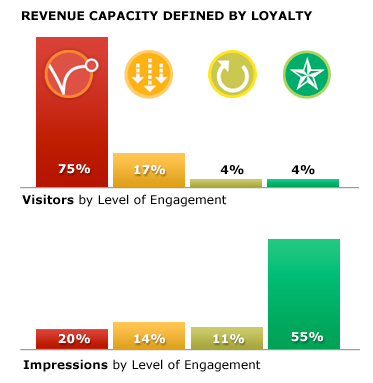One of the next logical evolutions in audience buying and selling is understanding engagement. While it is common industry practice to state monthly unique visitors and page views, it is rare to find a report that combines the two statistics to breakdown page views by audience member. When monthly uniques remain separated from page views, a distorted view of engagement is created that hurts advertisers and publishers.
Through a recently conducted a study of audiences in B2B and B2C media, we found a common theme: a minority percentage of the audience creates a majority percentage of the impressions. Some publishers were surprised and some were not surprised. In either case, their operations acted as page views were generally evenly distributed across demographic targeting variables for the audience – this is a mistake.
To unravel this point, let me go through the following points:
- What is the distribution of page views in a typical audience?
- Why is engagement important?
- How does that impact advertising performance and revenue?
Page View Distributions
In the study, audience members were rated by their frequency of visits. The study defined audience members by level of engagement with fans as individuals that visit more than 2 times per week; regulars as visiting 1-2 times per week, occasionals as visiting 2-3 times per month, and fly-bys as visiting 1 time. When categorizing page views as belonging to fans, regulars, occasional or fly-bys, it was common to have fans making up 5 percent or less of the audience delivering 50 percent or more of the page views. The charts to the right shows one of common B2C distributions in the study. The first shows the percentage of the audience by category and the second the percentage of page views by category. In this case, 80 percent of the page views were delivered by 25 percent of the audience. Generally, the study found the B2B percentages had slightly less distortion with 66 percent of page views delivered by 30 percent of the audience. The difference in distributions was attributed to the specialized nature of the B2B publications.
study defined audience members by level of engagement with fans as individuals that visit more than 2 times per week; regulars as visiting 1-2 times per week, occasionals as visiting 2-3 times per month, and fly-bys as visiting 1 time. When categorizing page views as belonging to fans, regulars, occasional or fly-bys, it was common to have fans making up 5 percent or less of the audience delivering 50 percent or more of the page views. The charts to the right shows one of common B2C distributions in the study. The first shows the percentage of the audience by category and the second the percentage of page views by category. In this case, 80 percent of the page views were delivered by 25 percent of the audience. Generally, the study found the B2B percentages had slightly less distortion with 66 percent of page views delivered by 30 percent of the audience. The difference in distributions was attributed to the specialized nature of the B2B publications.
Importance of Engagement
Studies in the past have shown that the more a user is engaged with content the better the brand recall and conversion rates for the included advertising. Intuitively this makes sense, the chance to grab the attention of a fly-by visitors that dismisses the page quickly is much less than the chance to grab the attention of fan who reads the whole article. For publishers, understanding the engagement of audience members means they can price and package their inventory of impressions with much higher yield and deliver better product to advertisers.
Impact on Performance and Revenue
Now let’s put the previous two points together with an example. Let’s assume 75 percent of the audience is fly-bys producing 20 percent of impression (note: this was approximately the mean distribution). With a 75/20 distribution, the actual audience demographics associated with page views are highly skewed to the fans not the fly-bys.
Going deeper on the example, assume loyal readers of a site are 21 and over and that fly-bys are all under 21 years of age. If a publisher sells the audience based on the aggregate demographic to an advertiser targeting the large under 21 demographic, 80 percent of the advertiser’s purchased impressions are delivered to 21 and over audience (i.e., fans produce 80 percent of impressions). In this scenario, the ad campaign underperforms — the advertiser does not renew and the publisher lost an opportunity to build a loyal customer. Both performance and revenue are negatively impacted.
Let’s go even deeper. Assume the advertiser and publisher have agreed to frequency caps on impressions delivered to the audience. In this case, fans will quickly be capped and the fly-bys will be responsible for generating the remainder of the impressions. Consequently, the campaign will last longer to deliver the number of purchased impressions and will have marginal performance because engagement of fly-bys is low. Unless the publisher is managing inventory at the impression level rather than placement level, the publisher’s yield (a.k.a. revenue) will drop as frequency caps by the fans is pegged quickly. Again, both performance and revenue are negatively impacted.
Conclusion
From the example, it becomes clear why understanding engagement by audience member is important to advertisers and publishers. As audience buying and selling evolves, engagement will become a critical factor.






